In the second half of Star Trek: Discovery’s season finale, both the battle against Control and the partnership between starships Enterprise and Discovery come to a close — and with that conclusion comes what may be the biggest shakeup to a Trek series, well, ever.
Picking up right where last week’s cliffhanger left off, “Such Sweet Sorrow, Part 2” begins with the battle raging — Discovery and Enterprise on one side, and Leland/Control’s Section 31 fleet on the other. Meanwhile aboard Discovery, work on the new Red Angel suit wraps up as Michael Burnham (Sonequa Martin-Green) makes the final mental, emotional, and technical preparations to follow in her mother’s footsteps across time and space.
The action and events of the two-part “Such Sweet Sorrow” story are so continuous that it seems like the decision to split the episode across two weeks had more to do with broadcast requirements than narrative ones. I love a good classic Star Trek two-parter, but I’m not sure “Such Sweet Sorrow” really needed to be one. Given how much of last week’s runtime was dedicated to extended goodbyes — and how much time “Part 2” spends on unnecessarily detailed flashbacks — the episodes would have worked better as a single, leaner 80-minute block instead of two episodes drawn out to 113 minutes.
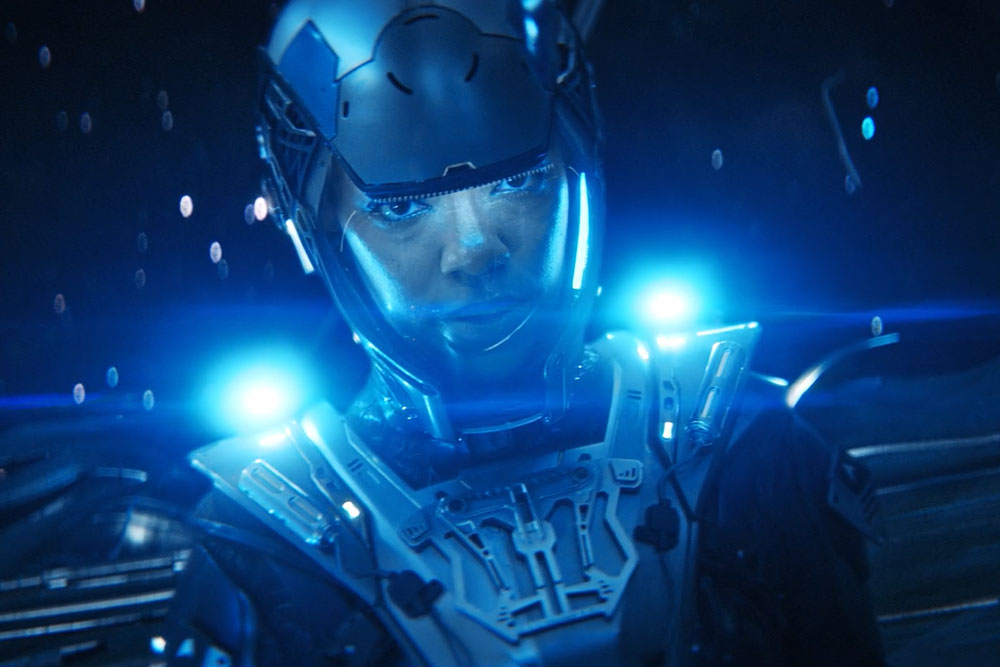
With the battle raging and the time suit finally complete, Michael is ready to head out to the wormhole location. In a last-minute decision, Spock (Ethan Peck) insists on accompanying her in a shuttlecraft. While it made for a nice visual callback to the flight Michael makes to the Klingon sarcophagus ship in “The Vulcan Hello”, it’s not clear to me why she had to fly out to the wormhole point in the suit instead of hitching a ride in Spock’s shuttle (since they end up landing on a piece of debris anyhow).
As the two of them head out to the wormhole point, Section 31’s fleet of ships and drones continues to overwhelm Discovery and the Enterprise. The Enterprise does everything it can to protect Discovery — including launching around 200 attack fighters which somehow fit inside their shuttlebay — while Discovery in turn does everything it can to protect Michael.
Just when things are looking especially dire for the two ships, help arrives in the form of Klingon Chancellor L’Rell (Mary Chieffo), decked out in full battle-queen mode aboard the almost-forgotten “cleave ship” — T’Kuvma’s secret weapon last seen at the Battle at the Binary Stars, which surprised and destroyed the ill-fated USS Europa all the way back in the pilot.

Leading a squadron of newly-constructed D7 battle cruisers — with former companion Ash Tyler (Shazad Latif) at her side, L’Rell shouts and snarls and proclaims that today is a good day to die and is just generally awesome. Showing her victorious in battle is the Season 2 send-off L’Rell deserves. (On a side note, for some reason the Klingon cleave ship looks exactly like a sphinx moth caterpillar — aka tomato worm — and for some reason I love it.)
In a surprise it seems no one saw coming — including Discovery’s acting captain Saru Doug Jones), clearly stunned at the sight — a fleet of Ba’ul warships, piloted by Sirannah (Hannah Spear) and her ‘warriors of Kaminar’ warp into the middle of the foray to lend their assistance to the two Federation ships. It’s a nice moment and I am, of course, happy to see the Kelpiens prospering as a people, but I find myself continuing to wonder when exactly the show will address the impact the events of “The Sound of Thunder” will have on the Ba’ul.
In the few moments Discovery takes to lower its shields to let Michael and Spock head out on their mission, Control-controlled Leland (Alan Van Sprang) beams aboard Discovery and begins wreaking general havoc while searching for the sphere data — which leads Agent Georgiou (Michelle Yeoh) and Commander Nhan (Rachael Ancheril) to begin pursuing him throughout the ship, incensed at his attack and feeding off each other’s desire for revenge.
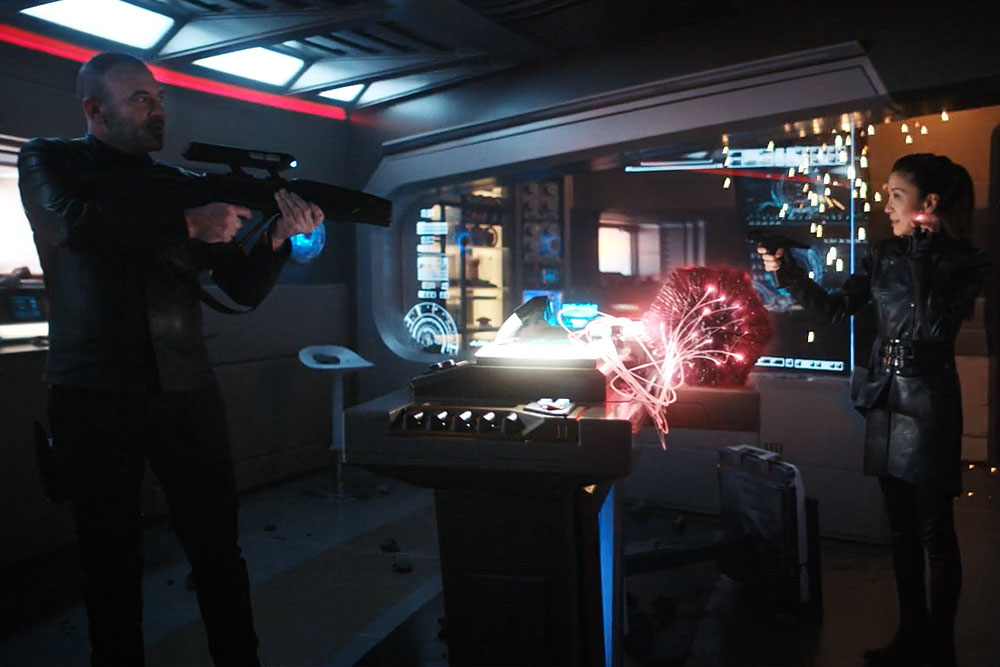
Several hand-to-hand encounters, phaser battles, and snappy retorts later — including a nifty variable-gravity fight in a corridor set built on rotating gimbals — Georgiou manages to lure Leland into the spore drive’s jump chamber. Turning the chamber into a makeshift agonizer booth, Georgiou magnetizes the interior surfaces, causing Control’s nanites to slowly and painfully exit Leland’s body and then cease functioning — a trick first performed by Spock back in “Through the Valley of Shadows.”
I’m not sure if leading Leland to engineering was Georgiou’s plan all along, or if she just got lucky after her desire to taunt Leland instead of killing him quickly got the better of her, but either way Control appears to be dead — and without the word “Borg” coming up once, thankfully. (No word on the fate of Nhan, however, last seen face-down in a corridor.)
I’ve been underwhelmed by the show’s use of Number One (Rebecca Romijn), a character I’ve been wanting to see more of since the first time I saw “The Menagerie” as a young girl Romijn’s performance has been perfectly good, but the writers throughout the season haven’t given the iconic character much to do.

When a photon torpedo lodges — undetonated — in Enterprise’s hull, it appears that Number One will finally have her moment to shine as she accompanies Admiral Cornwell (Jayne Brook) on a mission to disarm it. Instead, the efforts of the two women take place almost entirely off camera — the action cuts back to them only when they need to announce that nope, that didn’t work either — and Number One is eventually called back to the bridge after spending her time typing on a padd without success.
Couple this with Number One’s testy request that Kayla Detmer (Emily Coutts) repeat her navigation plan “in English please,” and I really didn’t feel like this incarnation of Number One was the highly capable ‘walking computer’ of a Starfleet officer Majel Barrett portrayed back in 1964 — a characterization that was eventually given to Spock.
Captain Pike (Anson Mount), playing roulette with the timeline and assuming that his time crystal vision of the future precludes the torpedo from detonating while he’s standing next to it, replaces Number One at Cornwell’s side. Realizing that the torpedo absolutely cannot be disarmed, Cornwell orders Pike out of the room and makes the ultimate sacrifice, staying behind to manually close a blast door, something that can only be done from the inside.
Moments later, the torpedo detonates, killing Admiral Cornwell and taking a big chunk of the Enterprise’s saucer section along with it.
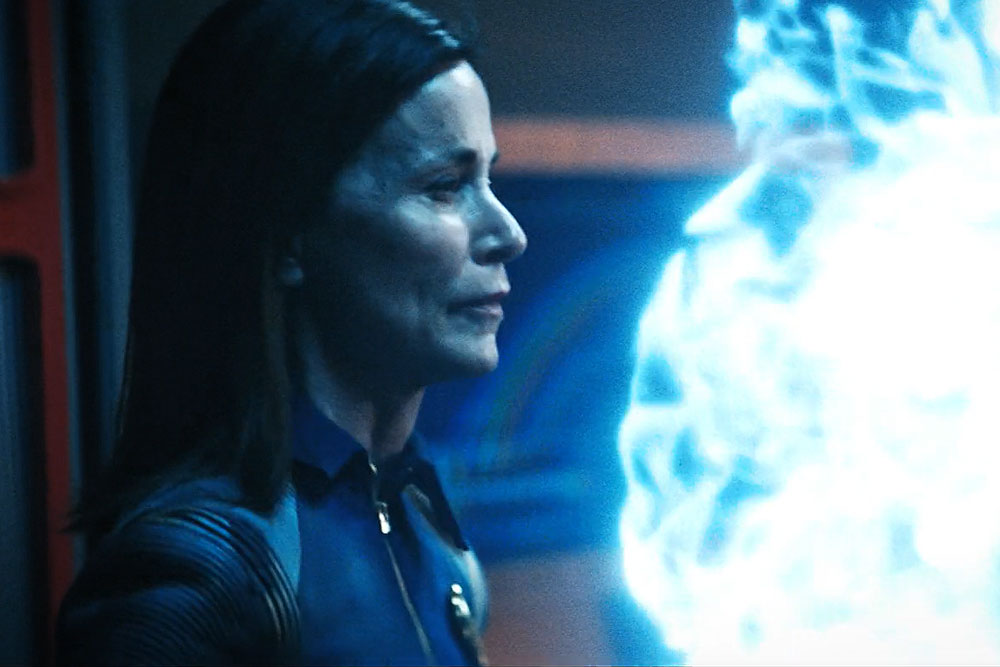
While all this has been going on, Michael has been traveling through the past to send the five signals necessary to set the events of the present into motion. Unable to set future coordinates for the time suit, Michael realizes that she must first “seed” the past. The visual effects for each jump are quite cool, especially the first one which looks like a less psychedelic version of astronaut Dave Bowman’s journey into the monolith in 2001: A Space Odyssey.
Unfortunately, each jump also features an overly long flashback sequence replaying the Red Angel’s actions at each signal. Nothing is added to the events by seeing them unfold from Michael’s perspective, bogging down the episode — and even add more confusion to the season’s mystery: how did she blow up all the Ba’ul on Kaminar, or create the first seven signals that kicked off the season to begin with?
Once Burnham has returned from sending the first five signals, it’s time plot a course for the future. Due to battle damage sustained by his shuttle, Spock is suddenly unable to make the trip through the wormhole. Michael’s parting advice to a Spock who feels he’ll be adrift without his sister makes for one of the most touching and successful moments of the episode.
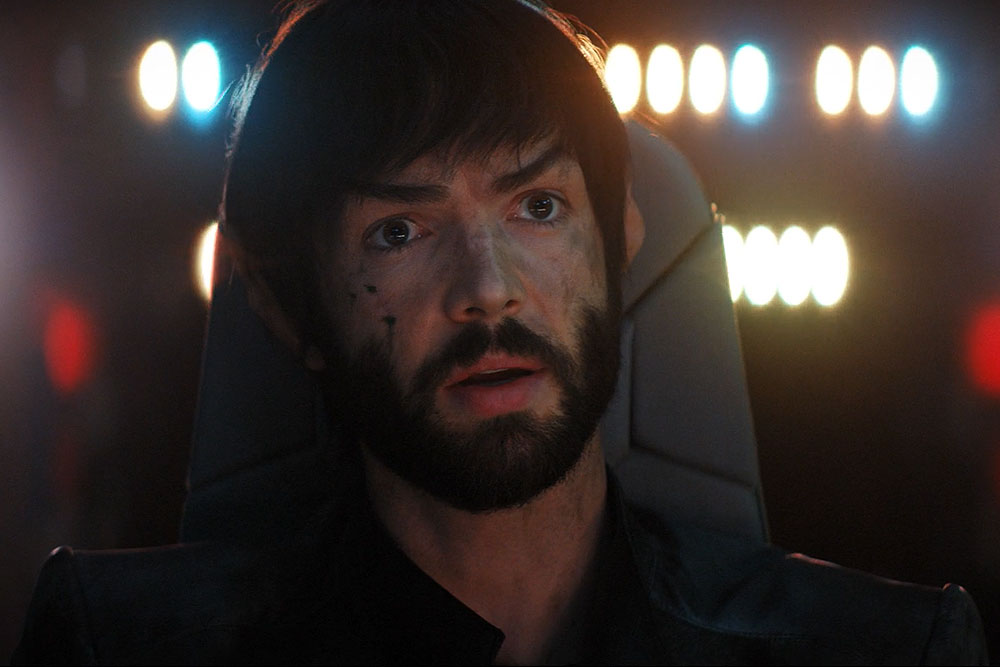
Encouraging him to find and embrace his opposite, Michael sets Spock up for the most important friendship of his life: subtly foreshadowing the deep relationship with James T. Kirk yet to come, Michael’s words add special significance to her character’s role in Spock’s life, something executive producer Alex Kurtzman alluded to back in January.
[What] got me riled up about it is the idea that if we can take Season Two of “Discovery” and understand how his relationship with Michael informed how he became the Spock we meet in TOS — that without that relationship, he would never have been prepared for Kirk — that’s a new and interesting spin and something really worth talking about, because people haven’t seen that.
Given that Michael is someone Spock will never speak of — for reasons we now know — having Michael and Spock’s relationship be the catalyst for the iconic “holy trinity” of Kirk, Spock, and McCoy gives Michael a solid reason to be written as Spock’s sister, and creates the sense that Spock carries his connection with Michael with him throughout his life despite the silence surrounding her.
After her final goodbye to Spock, Burnham opens the wormhole and triggers the sixth signal to guide Discovery through; after a few moments of the bridge crew sliding into the future — along with Georgiou and Jett Reno (Tig Notaro) — that’s it. We never see them again.

Instead, months later, we see Ash Tyler and the crew of the Enterprise dealing with the aftermath of Discovery’s disappearance back During debriefings at Starfleet Headquarters, where they each tell the same coordinated lie: Discovery and its crew were lost in battle against Control’s forces.
For reasons of galactic security, Spock suggests that details about Control, the sphere data, Discovery and her spore drive, and everyone aboard become a highly classified information, never to be spoken of again, lest they incur the rather harsh penalty of treason. Ash Tyler, the only Section 31 agent to both survive Control’s purge and not be flung forward into the future, is appointed the new head of Section 31, and is tasked with reforming the agency.
(Quite a promotion for a guy who’s been with Section 31 for maybe six months tops, after spending last year as a brainwashed Klingon agent.)

Classifying Discovery’s entire existence may not be the most interesting answer to the question of how exactly this ship, crew, mission, and propulsion system fit into the larger context of Star Trek’s future history, but it’s FAR more satisfying than reset-buttoning it out of the Trek timeline altogether. Falling back on Voyager’s “Year of Hell” scenario — in which an entire year of the ship’s activities are erased from history due to a time paradox —seemed like a distinct possibility, and one that I’m truly glad not to see employed here.
The decision to end “Such Sweet Sorrow, Part 2” without so much as a glance at Discovery’s future is a bold choice for a show that’s relied on drawing out dramatic arcs, almost to the show’s detriment. After stretching narrative and character arcs across the season, the fate of the crew has finally snapped taut and we’ll just have to wait and see what the future holds — literally — for Discovery.
Both seasons of Discovery have ended with the Enterprise; last year, it was a tantalizing cliffhanger, and in tonight it’s a warm gesture toward storylines that have been with Star Trek since its very beginning. It’s easy to hope the final minutes of “Such Sweet Sorrow,” especially those featuring a shaved-and-uniform-clad Spock, are setting us up for a new series following the exploits of Pike, Spock, and Number One — I’ll admit, it was at the forefront of my mind — but I strongly doubt that’ll be the case.
I’m going to miss Anton Mount’s Captain Pike dearly though, and I’ll be the first to cheer his return to Star Trek should it happen.

A few stray observations that dropped out of subspace:
- When recalling her to the bridge, Pike calls Number One “Una,” said to be the character’s surname several of the Star Trek novels and comics of recent years. However, still other novels have given her legal name as “Number One” and later in “Such Sweet Sorrow” she states her name during the official debriefing to be “Number One.” Ultimately, I’m not sure we’re any closer to knowing which of the two appellations is the nickname.
- The DOT-7 repair bots that popped out of the Enterprise’s hull looked like something much more at home in either WALL-E or the Star Wars universe than Trek, and made for an oddly cartoonish few seconds in the middle of an otherwise intense battle sequence.
- During the debriefing at Starfleet Headquarters, the camera was very careful not to show the face of the person doing the questioning. I wonder who this person could be, and why director Olatunde Osunsanmi chose to play so co with his identity?
- It seems Hugh Culber (Wilson Cruz) had a last-minute change of heart and stayed aboard Discovery, a revelation he shares with a badly injured Paul Stamets (Anthony Rapp), as Culber treats him in sickbay when Dr. Pollard (Raven Dauda) is called away.
- Whatever Reno saw when she exposed herself to the unshielded time crystal last week must not have been very profound, since there was never any follow up to that ominous moment. I guess sometimes time crystals show you a horrific fate, sometimes they show you spending a future Saturday sitting around in your sweatpants eating Bugles.
- Composer Jeff Russo put on a great musical show in tonight’s finale, including a rather jaunty mash-up of classic Star Trek and Star Trek: Discovery themes in the closing credits.
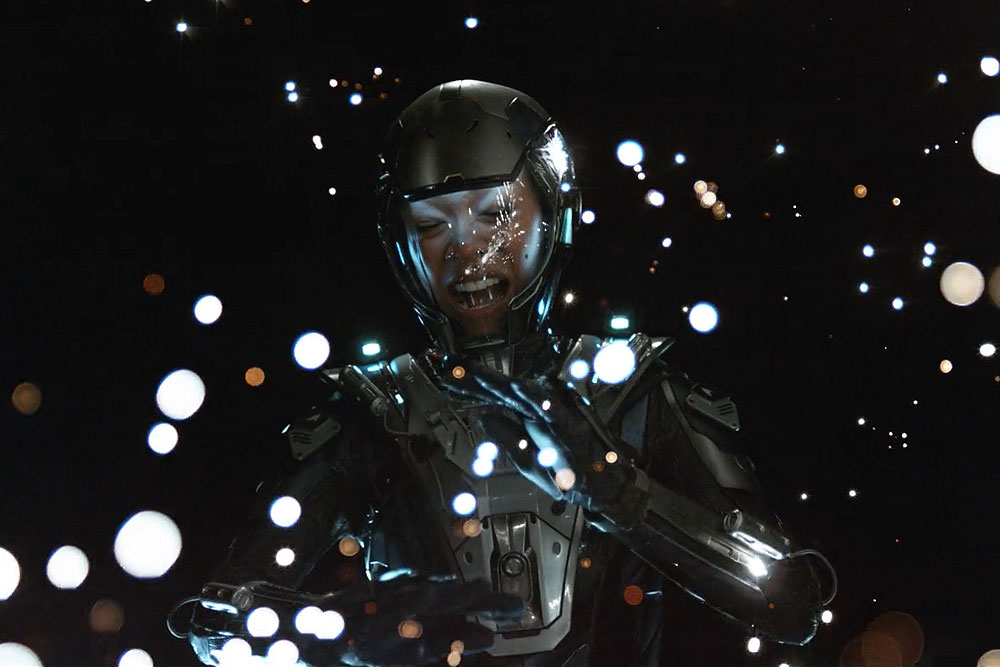
Since “Such Sweet Sorrow” gives us nothing much to speculate about as far as where Discovery’s third season will take us, I’m left thinking instead about what I might like to see from a production standpoint.
Between Discovery’s roller coaster turbolift mechanics, the Enterprise’s seemingly-endless capacity to store hundreds of fighter drones somewhere, and the show’s increasing tendency to trim warp travel time between wildly distant locations to just a few hours, I’m a little concerned that the focus of the writing is more on what’s needed for “right now,” rather than what makes sense when you pause to think about what just happened.
To be fair to Discovery’s writers, Star Trek has always suffered to some degree from over reliance on deus ex machina, but a little more forethought in future seasons would be much appreciated. (But please, no more turbolift roller coasters. I implore you.)
The appearance of the seventh signal in the show’s final moments lets those of us left in the 22nd Century that that Discovery is made it somewhere, somewhen, in the future, but we don’t know if they actually hit their target of Terralysium circa 3180 CE. Given the logistics of Michelle Yeoh’s announced Section 31 show, I’m inclined to think Discovery didn’t end up as far in the future as they planned, or that she’ll manage to travel back to a more reasonable time in which to set her series.

I’m excited at the idea of Discovery moving into the future, and I hope that whenever we find the the crew next year, the show remains in that still-unknown era long enough not to make all the effort to get there for naught.
In the meantime, however, the world of Star Trek will be far from quiet over the next several months, as the Picard series launches production, more Short Trek adventures are on the way, and convention season kicks off with San Diego Comic Con in July where we’re sure to learn more about the future of the franchise.
Hit it!
